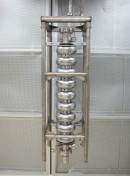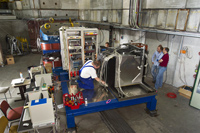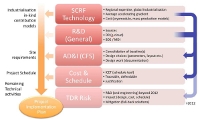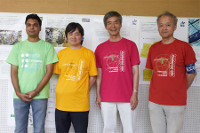China reaching the target gradient

PKU3, the first nine-cell cavity in China reaching a gradient usable for the ILC, in JLab clean room before vertical test. Image: Fumio Furuta |
A 1.3-gigahertz TESLA-type nine-cell niobium superconducting cavity, named PKU3, as the third nine-cell cavity fabricated by the superconducting radiofrequency (RF) group at Peking University, Beijing, China, achieved an accelerating gradient of 28.6 megavolts per metre (MV/m) at an unloaded quality factor of 4×109 in its second vertical test at Jefferson Lab (JLab), USA on 9 August 2010. This cavity is the first nine-cell cavity with end group components in China reaching a gradient usable for the ILC.
Read more...
-- Jiankui Hao, Peking University |
 |
|
|
 |
 |
|
|
 |
| Upcoming meetings, conferences, workshops
First Baseline Assessment Workshop
KEK, Tsukuba, Japan
7-10 September 2010
XXV Linear Accelerator Conference (LINAC10)
Tsukuba, Japan
12-17 September 2010
Topical Workshop on Electronics for Particle Physics (TWEPP-10)
Aachen, Germany
20-24 September 2010
Symposium on the Superconducting Science and Technology of Ingot Niobium
Jefferson Lab, Newport News, USA
22-24 September 2010
1st International Workshop on Accelerator-Driven Sub-Critical Systems & Thorium Utilization
Virginia Tech, Blacksburg, Virginia, USA
27-29 September 2010
19th International Spin Physics Symposium (SPIN 2010)
Juelich, Germany
27 September - 2 October 2010
EUDET Annual Meeting 2010
DESY, Hamburg, Germany
29 September - 1 October 2010
High precision measurements of luminosity at future linear colliders and polarization of lepton beams
Tel Aviv University, Tel Aviv, Israel
3-5 October 2010
Upcoming schools
Fifth International Accelerator School for Linear Colliders
Villars-sur-Ollon, Switzerland
25 October - 5 November 2010
|
|
|
GDE Meetings calendar
View complete ILC calendar
|
|
|
 |
Textbook tests with tungsten
CERN's linear collider detector group joins forces with CALICE in building the world's first tungsten hadronic calorimeter.

Hadronic calorimeter prototype made of tungsten for the linear collider detector being equipped with CALICE scintillators. Image: CERN/M. Brice
|
In a hall for test beam experiments at CERN, next to the CLOUD climate experiment and an irradiation facility, sits a detector prototype that is in many ways a first. It's the first ever hadronic sandwich calorimeter (HCal) prototype made of tungsten. It's the first prototype for a detector for the Compact Linear Collider Study CLIC, developed by the linear collider detector R&D group (LCD group) at CERN. And it's the first piece of hardware that results directly from the cooperation between CLIC and ILC detector study groups. Now its makers are keen to see first particle showers in their detector.
Read more...
-- Barbara Warmbein |
 |
|
|
 |
From Cern Bulletin
6 September 2010
Latest news from the LHC
Last week the LHC passed the threshold of 3 pb-1 total integrated luminosity delivered to the experiments, of which about half was delivered in just one week.
Read more... |
|
From New Scientist
3 September 2010
Physicists divided over life extension for US collider
Despite his support for extending the Tevatron, Van Kooten is keen to avoid cutting back on US participation in the LHC, as is Oddone. “That would just be shooting ourselves in the foot,” Van Kooten says.
Read more... |
|
From Wired
2 September 2010
String Theory Finally Does Something Useful
String theory has finally made a prediction that can be tested with experiments – but in a completely unexpected realm of physics.
Read more... |
|
From Nature
1 September 2010
Panel Throws Tevatron a Lifeline
Fermilab advisory committee has released a report recommending that the Tevatron's operations be extended until 2014, at a cost of around $150 million.
Read more... |
|
From The Economist
31 August 2010
Ye cannae change the laws of physics
If the fine-structure constant really does vary through space, it may provide a way of studying the elusive “higher dimensions” that many theories of reality predict, but which are beyond the reach of particle accelerators on Earth.
Read more... |
|
|
 |
 |
|
|
 |
Developing an ILC Project Implementation Plan

The ILC Project Implementation Plan (PIP) will outline models and options related to the key areas of practically realising the ILC. How the five themes of our present R&D and design programme input into our Project Implementation Plan is indicated. |
The Global Design Effort was formed to coordinate the international R&D efforts and to develop and evolve a global ILC design. The present phase of our work is focused on the key R&D projects needed to establish the reality of building an ILC and the design work is aimed at evolving the design documented in our Reference Design Report so as to be optimised for cost, risk and performance. We have established a plan for this programme that will result in a Technical Design Report by the end of 2012 that can be the basis of government decisions on the project and be the basis for developing site specific and project specific designs as the next step. Another important step is to develop a Project Implementation Plan (PIP) as a way to outline the options, models and plans for realising the ILC as a project.
Read more...
-- Barry Barish
Director's Corner Archive |
 |
|
|
 |
ILC in many colours

Regardless of the lingering heat of summer over 35°, more than 3300 people visited KEK Open house held on 5 September. ILC scientists at KEK welcomed visitors wearing colourful ILC tee shirts. From left to right: Arpit Rawankar, Hitoshi Hayano, Kaoru Yokoya, and Seiya Yamaguchi. Image: Nobu Toge
|
arXiv preprints
1009.1112
Non-linear QCD dynamics in two-photon interactions at high energies
1009.0719
Test beam studies for a highly granular GRPC Semi-Digital HCAL
|
|

